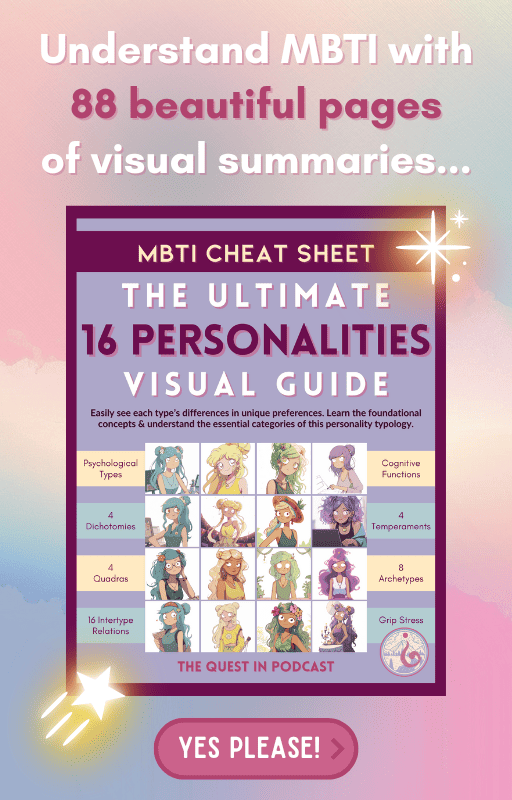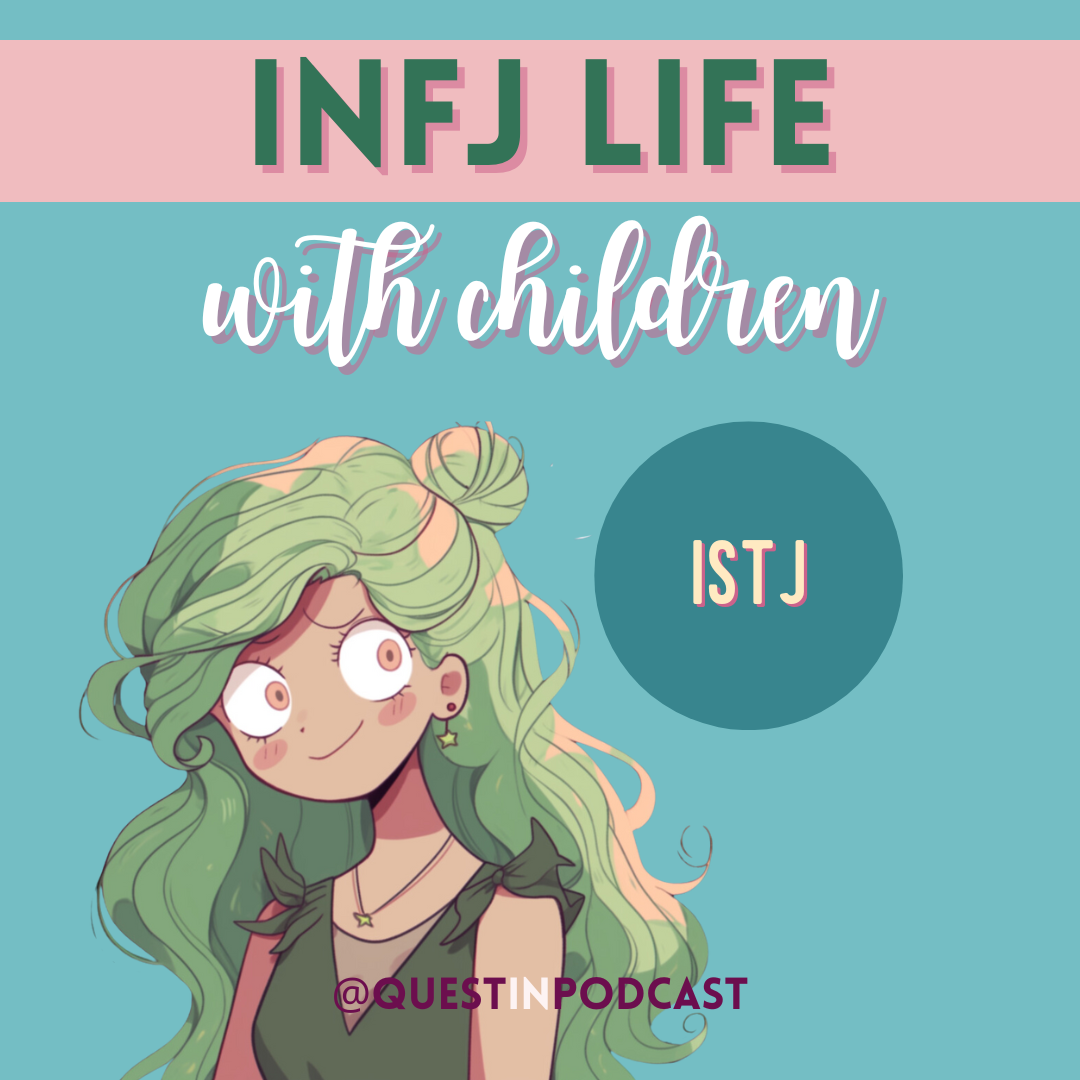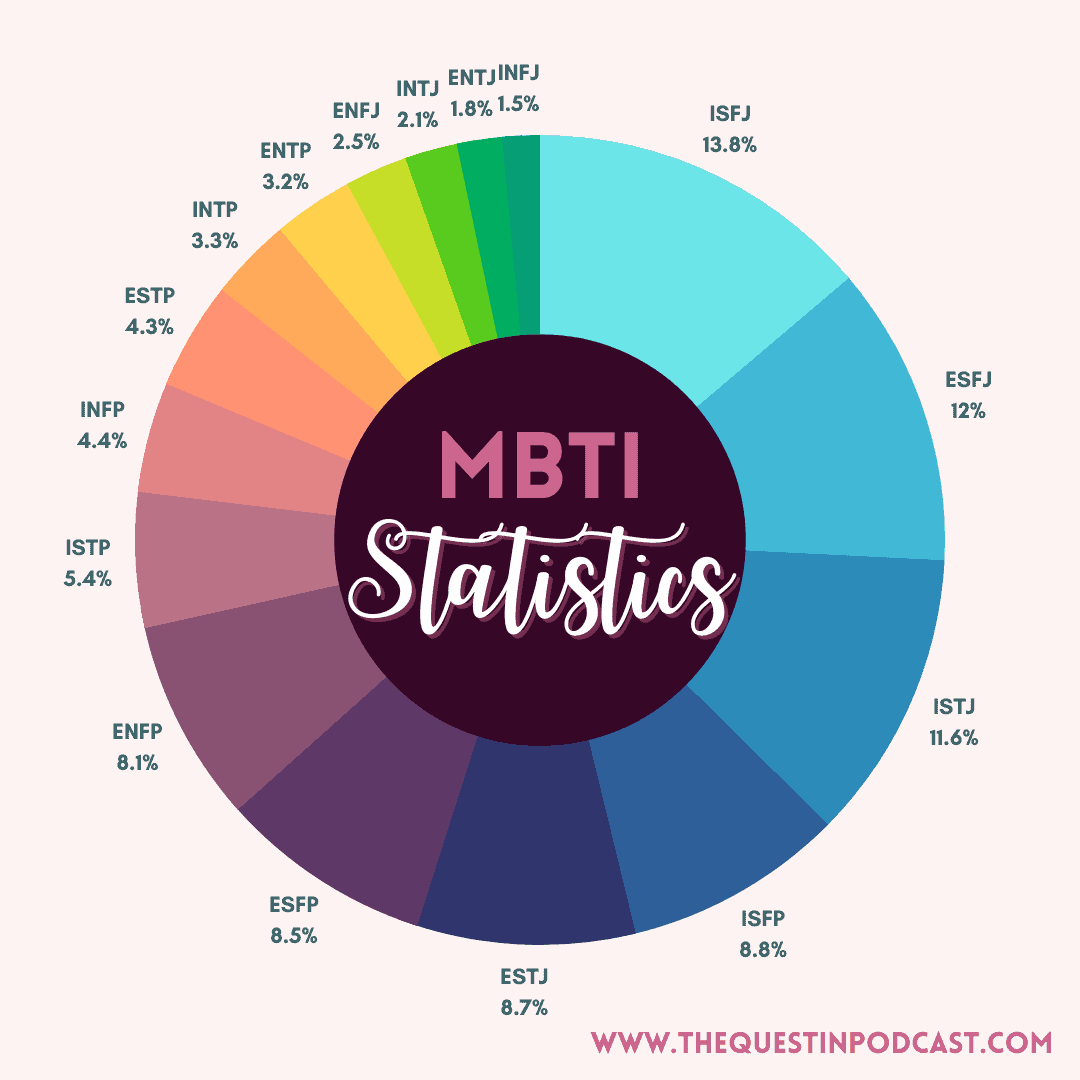
MBTI Statistics: All the Data on Personality Types
What are MBTI Statistics?
MBTI statistics reveal personality differences, personality preferences, and rare personality types. This article will help you to easily remember the estimated percentages of different personality traits in the general population.
To supplement all the data, I had some fun and went ahead to create a variety of infographics of the MBTI statistics for you.
Alright, let’s get started exploring the statistical data of all 16 personality types.
Percentage Estimates of MBTI Types
Most Common to Rarest Personalities
I have ordered this list from the most common personality type to the rarest personality type. These statistical figures were released by the Myers Briggs Company, aggregating data from 1972 through 2002.
-
ISFJ (Introverted, Sensing, Feeling, Judging): Approximately 13.8% of the population.
-
ESFJ (Extraverted, Sensing, Feeling, Judging): Approximately 12% of the population.
-
ISTJ (Introverted, Sensing, Thinking, Judging): Approximately 11.6% of the population.
-
ISFP (Introverted, Sensing, Feeling, Perceiving): Approximately 8.8% of the population.
-
ESTJ (Extraverted, Sensing, Thinking, Judging): Approximately 8.7% of the population.
-
ESFP (Extraverted, Sensing, Feeling, Perceiving): Approximately 8.5% of the population.
-
ENFP (Extraverted, Intuitive, Feeling, Perceiving): Approximately 8.1% of the population.
-
ISTP (Introverted, Sensing, Thinking, Perceiving): Approximately 5.4% of the population.
-
INFP (Introverted, Intuitive, Feeling, Perceiving): Approximately 4.4% of the population.
-
ESTP (Extraverted, Sensing, Thinking, Perceiving): Approximately 4.3% of the population.
-
INTP (Introverted, Intuitive, Thinking, Perceiving): Approximately 3.3% of the population.
-
ENTP (Extraverted, Intuitive, Thinking, Perceiving): Approximately 3.2% of the population.
-
ENFJ (Extraverted, Intuitive, Feeling, Judging): Approximately 2.5% of the population.
-
INTJ (Introverted, Intuitive, Thinking, Judging): Approximately 2.1% of the population.
-
ENTJ (Extraverted, Intuitive, Thinking, Judging): Approximately 1.8% of the population.
-
INFJ (Introverted, Intuitive, Feeling, Judging): Approximately 1.5% of the population.
This data is from The Myers Briggs Foundation, which says “The estimated frequency table was compiled from a variety of MBTI® results from 1972 through 2002, including data banks at the Center for Applications of Psychological Type; The Myers-Briggs Company; and Stanford Research Institute (SRI).”
Unfortunately, it is not indicated whether this reflects data from a global sample or if it is limited to the United States population.
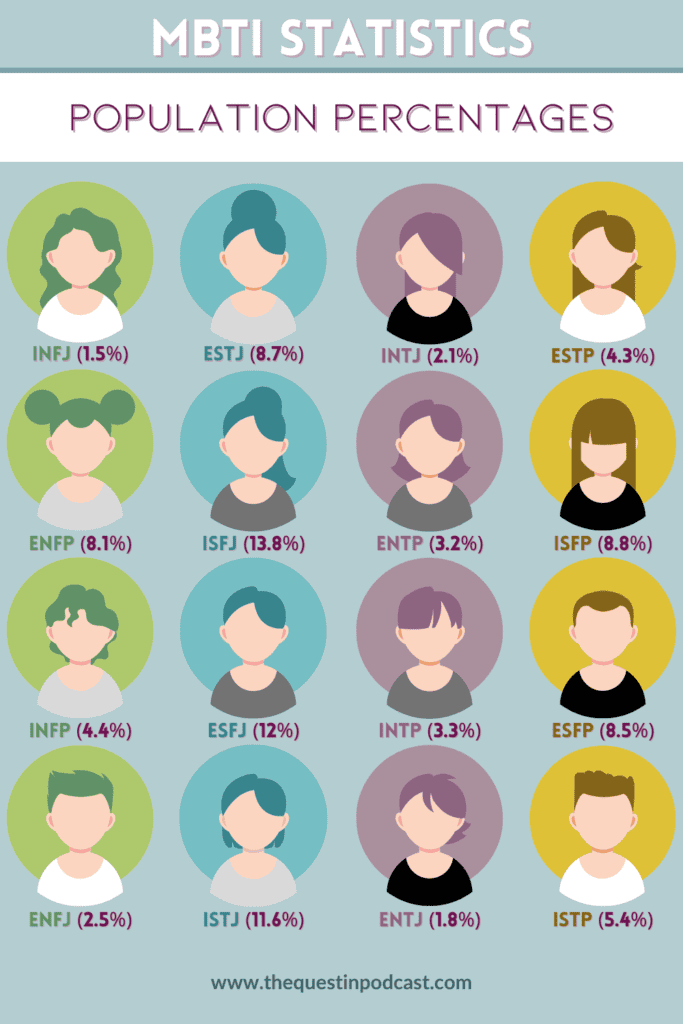
Understanding the Personality Preferences of MBTI
4 Dichotomies of Personality Traits in MBTI
-
Introversion versus Extroversion (I vs E)
-
Intuition versus Sensing (N vs S)
-
Feeling versus Thinking (F vs T)
-
Judging versus Perceiving (J vs P)*
The TRUTH About Judgers vs Perceivers*
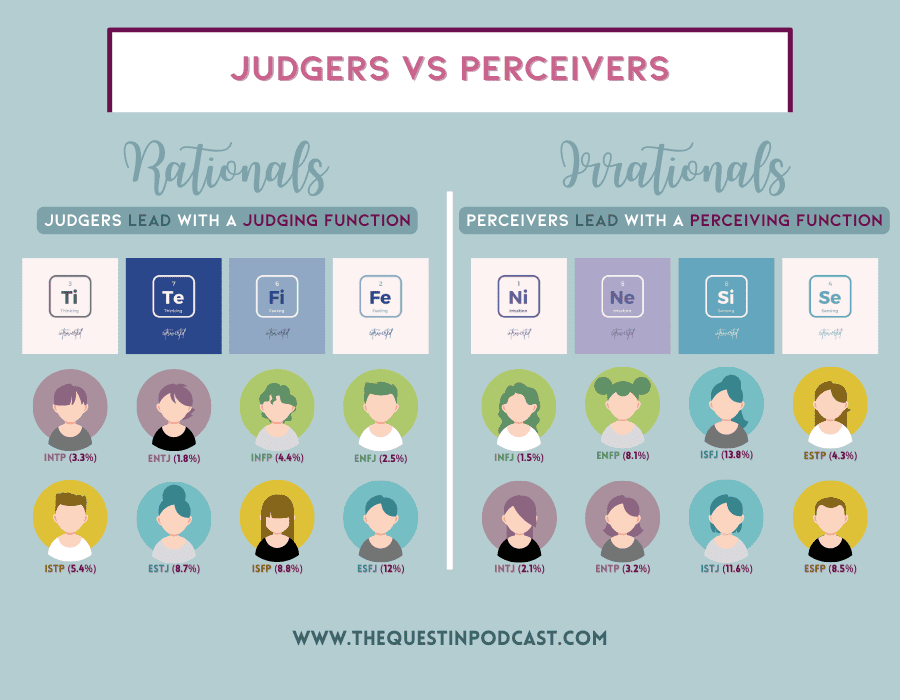
Only the extroverts in MBTI are represented correctly as either a judger or a perceiver by the last letter in their MBTI type code. (i.e. ENFP, ENTP, ESFP, & ESTP are perceivers and ENFJ, ENTJ, ESFJ, & ESTJ are judgers)
However, introverts in MBTI are represented by the opposite letter of judging and perceiving. This means that the INFJ, INTJ, ISFJ, & ISTJ are actually PERCEIVERS despite having a “J” in their type code. Likewise, the INFP, INTP, ISFP, & ISTP are actually JUDGERS despite having a “P” in their type code.
MBTI Statistics: Personality Preference Percentages
MBTI Statistics for the 8 Functions Dominance
This indicates the total percentage of the two types combined that lead with each of the 8 cognitive functions as their dominant function.
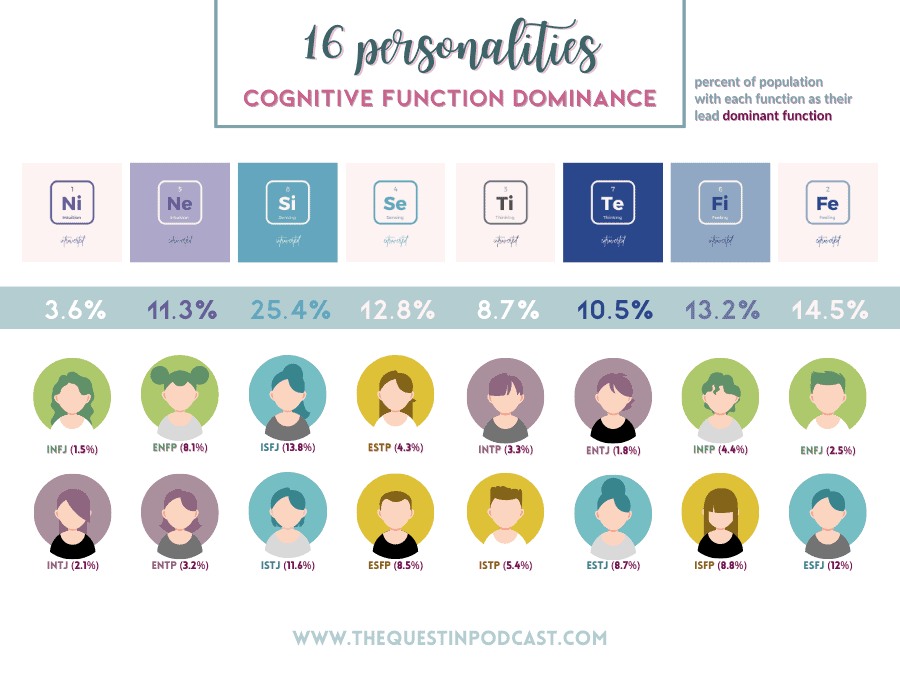
-
Introverted Intuition INTJ + INFJ: 2.1% + 1.5% = 3.6% (Ni)
-
Extroverted Intuition ENFP + ENTP: 8.1% + 3.2% = 11.3% (Ne)
-
Introverted Sensing ISFJ + ISTJ: 13.8% + 11.6% = 25.4% (Si)
-
Extroverted Sensing ESTP + ESFP: 4.3% + 8.5% = 12.8% (Se)
-
Introverted Thinking INTP + ISTP: 3.3% + 5.4% = 8.7% (Ti)
-
Extroverted Thinking ENTJ + ESTJ: 1.8% + 8.7% = 10.5% (Te)
-
Introverted Feeling INFP + ISFP: 4.4% + 8.8% = 13.2% (Fi)
-
Extroverted Feeling ENFJ + ESFJ: 2.5% + 12% = 14.5% (Fe)
MBTI Statistics for Introversion versus Extroversion (I vs E)
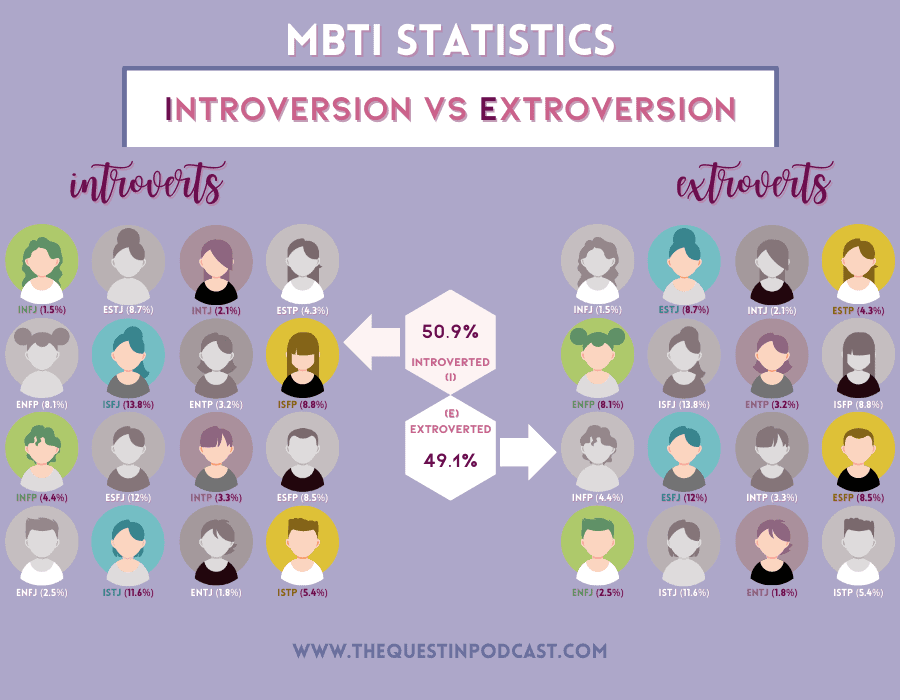
Introverts = INTJ + INFJ + ISFJ + ISTJ + ISTP + INTP + ISFP + INFP
Total Percentage: 2.1 + 1.5 + 13.8 + 11.6 + 5.4 + 3.3 + 8.8 + 4.4 = 50.9% (I)
Extroverts = ENFP + ENTP + ESFP + ESTP + ESTJ + ENTJ + ESFJ + ENFJ
Total Percentage: 8.1 + 3.2 + 8.5 + 4.3 + 8.7 + 1.8 + 12 + 2.5 = 49.1% (E)
MBTI Statistics for Intuitives versus Sensors (N vs S)
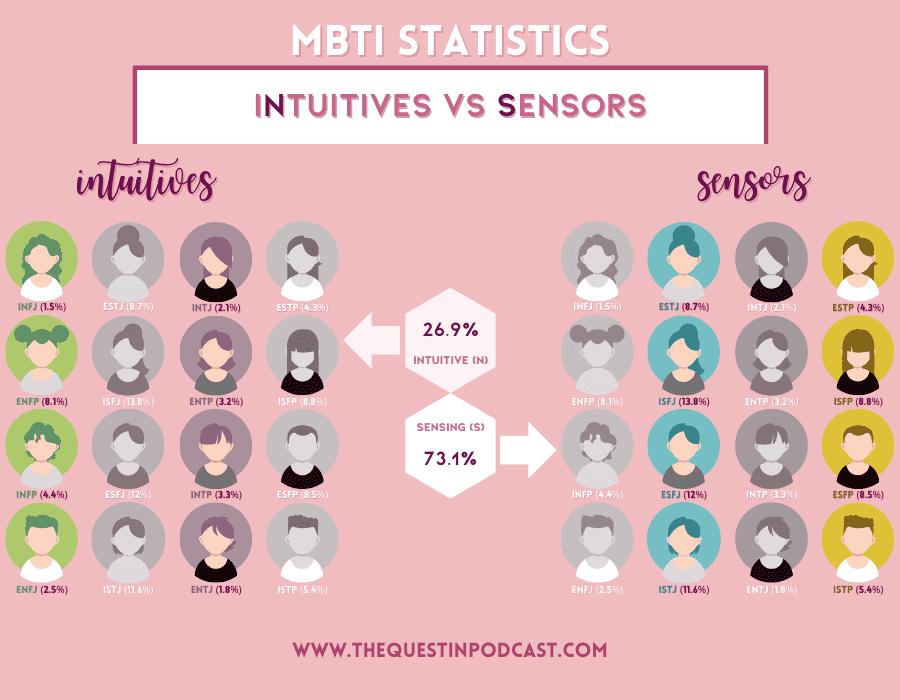
Intuitives = INTJ + INFJ + INTP + INFP + ENTJ + ENFJ + ENTP + ENFP
Total Percentage: 2.1 + 1.5 + 3.3 + 4.4 + 1.8 + 2.5 + 3.2 + 8.1 = 26.9% (N)
Sensors = ISFJ + ISTJ + ISTP + ISFP + ESFJ + ESTJ + ESTP + ESFP
Total Percentage: 13.8 + 11.6 + 5.4 + 8.8 + 12 + 8.7 + 4.3 + 8.5 = 73.1% (S)
MBTI Statistics for Feelers versus Thinkers (F vs T)
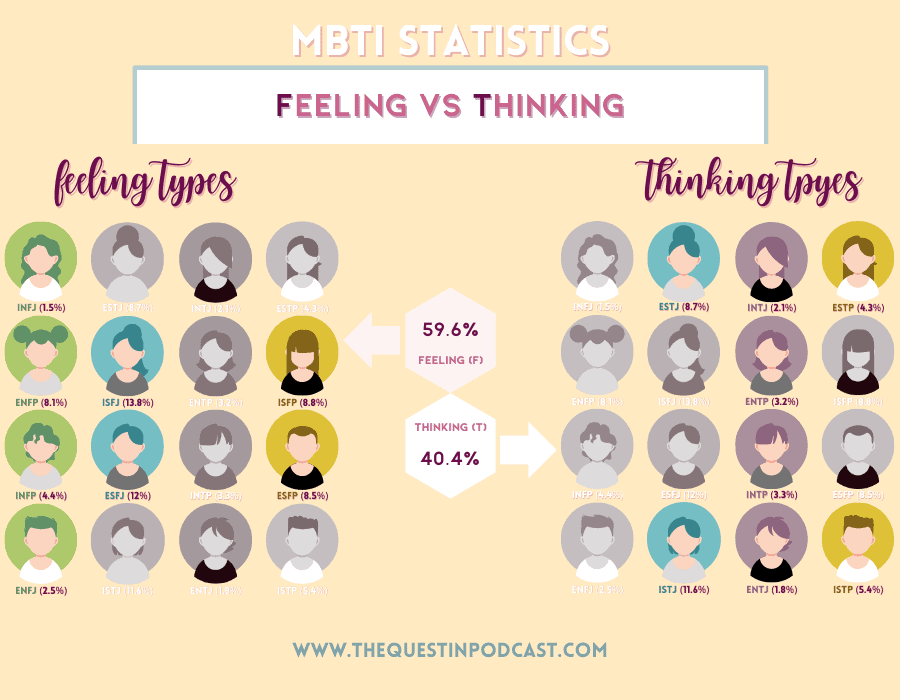
Feelers = INFJ + ISFJ + INFP + ISFP + ENFJ + ESFJ + ENFP + ESFP
Total Percentage: 1.5 + 13.8 + 4.4 + 8.8 + 2.5 + 12 + 8.1 + 8.5 = 59.6% (F)
Thinkers = INTJ + ISTJ + INTP + ISTP + ENTJ + ESTJ + ENTP + ESTP
Total Percentage: 2.1 + 11.6 + 3.3 + 5.4 + 1.8 + 8.7 + 3.2 + 4.3 = 40.4% (T)
MBTI Statistics for Judgers versus Perceivers (J vs P)*
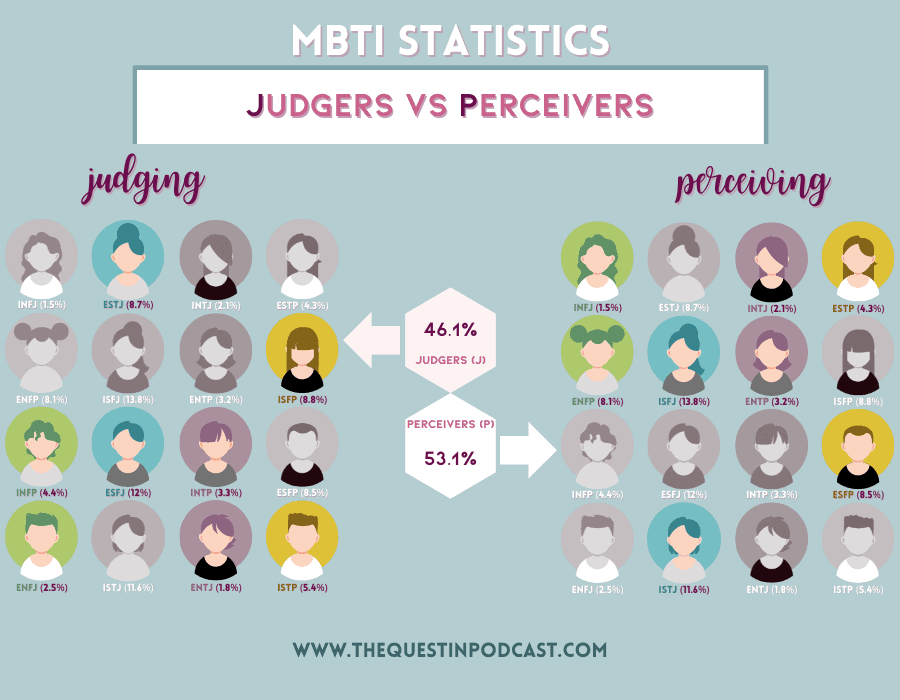
*Read “The TRUTH About Judgers versus Perceivers” above.
Judgers = ISTP + INTP + ESTJ + ENTJ + ISFP + INFP + ESFJ + ENFJ
Total Percentage: 5.4 + 3.3 + 8.7 + 1.8 + 8.8 + 4.4 + 12 + 2.5 = 46.1% Judgers (Leads with a dominant function that is a judging cognitive function, which is either Thinking or Feeling)
Perceivers = INTJ + INFJ + ENFP + ENTP + ISFJ + ISTJ + ESFP + ESTP
Total Percentage: 2.1 + 1.5 + 8.1 + 3.2 + 13.8 + 11.6 + 8.5 + 4.3 = 53.1% Perceivers (Leads with a dominant function that is a perceiving cognitive function, which is either Intuition or Sensing)
MBTI Statistics by Personality Temperaments
From most to least common temperament type.
Guardians (SJ) = ISFJ + ESFJ + ISTJ + ESTJ
Total Percentage: 13.8 + 12 + 11.6 + 8.7 = 46.1% Guardians
Artisans (SP) = ISFP + ESFP + ISTP + ESTP
Total Percentage: 8.8 + 8.5 + 5.4 + 4.3 = 27% Artisans
Idealists (NF) = ENFP + INFP + ENFJ + INFJ
Total Percentage: 8.1 + 4.4 + 2.5 + 1.5 = 16.5% Idealists
Analysts (NT) = INTP + ENTP + INTJ + ENTJ
Total Percentage: 3.3 + 3.2 + 2.1 + 1.8 = 10.4% Analysts
Rarest Personality Type

The INFJ Advocate personality type is known to be the rarest personality type at an estimated 1-3% of the population.
The original developer of psychological type theory, Carl Jung, has been typed to be this rarest personality type.
Other Rare Personality Types
The next rare personality types are INTJ Mastermind personality type, ENTP Debater personality type, ENFJ Mentor personality type, ENTJ Commander personality type, and INTP Researcher personality type.
INTJ is the second most rare personality type at an estimated 2-4%.
ENTPs, ENFJs, and ENTJs are the other rare personality types at an estimated 2-5%.
INTP is the sixth most rare personality type at an estimated 3-5%.
You will notice that the rarest MBTI type and other rare personality types are all intuitive types, which means that they all have a dominant or auxiliary function of intuition that can either be introverted intuition (Ni) or extroverted intuition (Ne). Intuitive MBTI types are very in-their-head individuals who frequently think in abstract concepts and of new ideas.
Most Common Personality Type

The ISTJ Inspector personality type is known to be the most common personality type in an estimated 11-14% of the population.
Other Common Personality Types
The other common personality types aside from ISTJ are ISFJ Defender personality type, ESTJ Supervisor personality type, ESFJ Caregiver personality type.
ISFJ is the second most common personality type at an estimated 9-14%, but would definitely have a higher ratio of women compared to men who type as ISFJs.
ESFJ is the third most common personality type at an estimated 9-13%.
ESTJ is the fourth most common personality type at an estimated 8-12%.
You will notice that all of the most common personality types are all sensor types, which specifically are SJ types which means that they have a “_S_J” type code.
These four types are all characterized by their guardian temperament and all have a dominant or auxiliary function of introverted sensing (Si). Guardians are stable, reliable, and duty-oriented individuals who are the foundation of society.
What is “MBTI” or “Myers Briggs Type Indicator”?
Myers Briggs Type Indicator is a type code of psychological type developed by Isabel Briggs Myers and Katharine Cook Briggs, but the original model was based on Carl Gustav Jung’s theories on psychological types.
Carl Jung’s theory on the 8 cognitive functions helps us understand communication styles, personality preferences, and decision-making logic of the 16 unique personality types.
The personality types tend to have a certain way of orienting themselves to the world that is identified through this psychological framework.
One word of caution is that many people may take the Myers-Briggs personality test and get a particular type as a result that may be inaccurate.
Any free personality test or online personality questionnaire tends to be quite limited.
Verifying a person’s type through the demonstrative use of cognitive functions works best to find out someone’s personality type.
You can learn why this is in the next section, where I explain how to read MBTI type code and use the rarest personality type as an example.
How to read MBTI code?
In 1962, the publication “Gifts Differing” by Isabel Briggs Myers took Carl Jung’s work and developed a 4-letter code that tells you the dominant 2 functions that each of the 16 types use.
In the example of the rare personality type “INFJ”, this code tells us that this personality type prefers the cognitive functions of Intuition (N) and Feeling (F).
The last letter “J” tells us that the judging function of Feeling is the extroverted function of the two, which means that this type has in their top 2 cognitive function preferences Extroverted Feeling (Fe) and Introverted Intuition (Ni).
The first letter “I” reveals that the type leads with their introverted function.
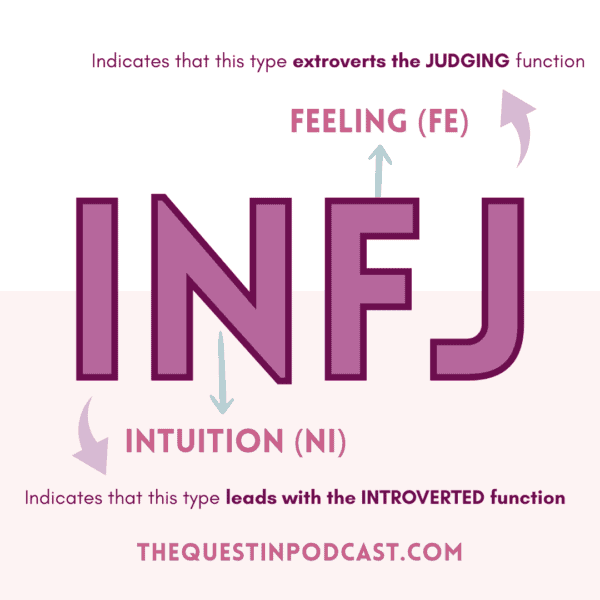
Therefore the INFJ is distinct in preferring to cognitively use Introverted Intuition (Ni) as their top/lead cognitive function and Extroverted Feeling (Fe) as their supportive function.
Each function operates on axes, so once you know 2 of them you know the order of the rest. The 4 axes are the Ni-Se axis, Ne-Si axis, Ti-Fe axis, and Fi-Te axis.
Now you know how to easily read the MBTI code for any of the 16 personality types!




